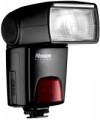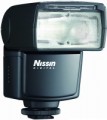Guide number
The guide number is the main characteristic that describes the power of the light pulse of the flash. It is described as the maximum distance (in metres) at which, at ISO 100 and f/1 lens speed (aperture 1), a flash is able to illuminate an "average" subject sufficiently for a normal exposure; in other words, at what distance from the flash it will be possible to normally shoot the scene at the specified ISO and aperture.
There are formulas by which, knowing the guide number, you can derive the practical shooting distance for each specific value of sensitivity and aperture. The simplest formula used to calculate the distance at ISO 100 is: S=N/f, where S is the distance, N is the guide number, f is the aperture value. For example, for a guide number of 56 and an f/2.8 lens, this distance would be 56/2.8 = 20 m. Increasing or decreasing sensitivity by a factor of 2 would increase or decrease the specified distance by approximately 1.4 times, respectively. If you need to calculate the distance as accurately as possible, you should refer to more detailed formulas that can be found in specialized sources.
Separately, it is worth noting that the leading numbers of flashes, usually, are indicated by manufacturers for specific focal lengths of lenses. This is due to the fact that the shorter the focal length and, accordingly, the wider the viewing angle, the more light is needed to illuminate the scene being shot and the more powerful the flash pulse should b...e (at the same distance). Therefore, when choosing by the guide number, it makes sense to pay attention to the focal length indicated by the manufacturer and select a model with a power reserve — especially since guide numbers are often prescribed for rather “long-range” lenses (with a focal length of about 80-100 mm in equiv. 35 mm).

